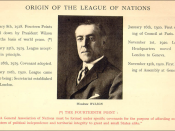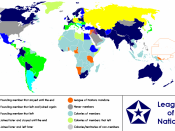The Disarmament conference was one of the many conferences organized by the League of Nations to disarm Nations for the purpose of peace. Others were the Washington Naval conference of 1922, and the London Naval Conference of 1930. These various conferences all had their imperfections in a way and for a conference to take two years and no result could be regarded as a failure... or was it?.
On February, 1932, the conference had begun in Geneva with a speech by the United States delegate, Ambassador Hugh Gibson. He said that the world's civilization was under threat because of the huge machinery and warfare that was being maintained; he also reminded everyone that they all swore not to wage war on each other so why would a massive amount of arms be needed in the first place?. According to a source, among the points he mentioned, he proposed: effective measures to protect civilian populations against aerial bombings; abolition of lethal gases and bacteriological warfare; prolonging the existing naval agreements that were concluded at Washington and London; and proportional reduction from the figures laid down in the Washington and London Naval agreements*.
On May, 1933, it appeared that the conference had done a lot of struggling concerning certain issues, but without any substantial progress. Getting tired of the conference's "slow motion", the American President, President Roosevelt, decided to liven it up a bit by sending a message on the 16th of May which was addressed to the 54 government heads, he defined the primary objective of the conference as " complete elimination of all offensive weapons"*/ and believing Germany to be the " only possible obstacle"*. Roosevelt passed his views to Dr. Schalt, President of the Reichsbank, one of Germany's central banks, who was in Washington, ten days earlier and hoped...



What is the reason of failure of Disarmament efforts?
Writer has given a good start line of the topic. In my view the most important point to ponder is the reason of its failure...Is it the discremination between the have and have nots, an effort to maintain unipolarity, lack of confidence and trust in the international system, or simply an eyewash...I still search for the answer...After all we all love and dream to have a peaceful and weapons free world...
2 out of 2 people found this comment useful.